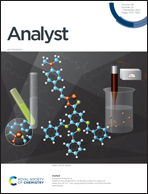Evaluation of table-top lasers for routine infrared ion spectroscopy in the analytical laboratory
Abstract
Infrared ion spectroscopy is increasingly recognized as a method to identify mass spectrometry-detected analytes in many (bio)chemical areas and its integration in analytical laboratories is now on the horizon. Commercially available quadrupole ion trap mass spectrometers are attractive ion spectroscopy platforms but operate at relatively high pressures. This promotes collisional deactivation which directly interferes with the multiple-photon excitation process required for ion spectroscopy. To overcome this, infrared lasers having a high instantaneous power are required and therefore a majority of analytical studies have been performed at infrared free electron laser facilities. Proliferation of the technique to routine use in analytical laboratories requires table-top infrared lasers and optical parametric oscillators (OPOs) are the most suitable candidates, offering both relatively high intensities and reasonable spectral tuning ranges. Here, we explore the potential of a range of commercially available high-power OPOs for ion spectroscopy, comparing systems with repetition rates of 10 Hz, 20 kHz, 80 MHz and a continuous-wave (cw) system. We compare the performance for various molecular ions and show that the kHz and MHz repetition-rate systems outperform cw and 10 Hz systems in photodissociation efficiency and offer several advantages in terms of cost-effectiveness and practical implementation in an analytical laboratory not specialized in laser spectroscopy.



 Please wait while we load your content...
Please wait while we load your content...